Top Rankings
San Marcos Unified School District ranks among the top 20% of public school district in California for:
Category
Attribute
Overall Rank
Highest overall rank (Top 20%)
Math Proficiency
Highest math proficiency (Top 20%)
Reading/Language Arts Proficiency
Highest reading/language arts proficiency (Top 20%)
Diversity
Most diverse schools (Top 1%)
Community Size
Largest student body (number of students) (Top 1%)
For the 2025 school year, there are 4 public high schools serving 6,358 students in San Marcos Unified School District. This district's average high testing ranking is 8/10, which is in the top 30% of public high schools in California.
Public High Schools in San Marcos Unified School District have an average math proficiency score of 31% (versus the California public high school average of 28%), and reading proficiency score of 60% (versus the 51% statewide average).
Public High School in San Marcos Unified School District have a Graduation Rate of 95%, which is more than the California average of 87%.
The school with highest graduation rate is San Marcos High School, with 96% graduation rate. Read more about public school graduation rate statistics in California or national school graduation rate statistics.
Minority enrollment is 65% of the student body (majority Hispanic), which is less than the California public high school average of 79% (majority Hispanic).
Overview
This School District
This State (CA)
# Schools
19 Schools
2,817 Schools
# Students
19,355 Students
2,139,525 Students
# Teachers
796 Teachers
100,737 Teachers
Student : Teacher Ratio
24:1
24:1
District Rank
San Marcos Unified School District, which is ranked #333 of all 1,925 school districts in California (based off of combined math and reading proficiency testing data) for the 2021-2022 school year.
The school district's graduation rate of 95% has stayed relatively flat over five school years.
Overall District Rank
#335 out of 1941 school districts
(Top 20%)
(Top 20%)
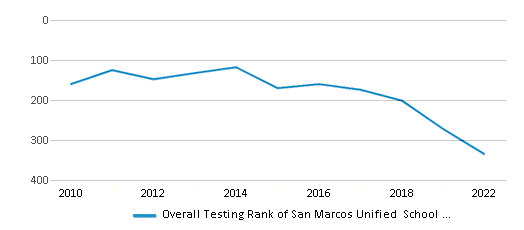
Math Test Scores (% Proficient)
46%
33%
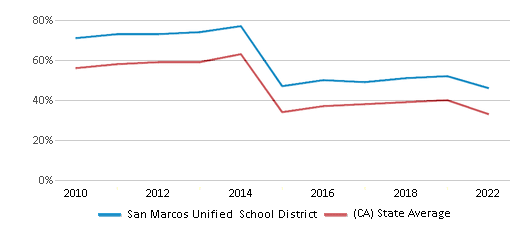
Reading/Language Arts Test Scores (% Proficient)
60%
47%
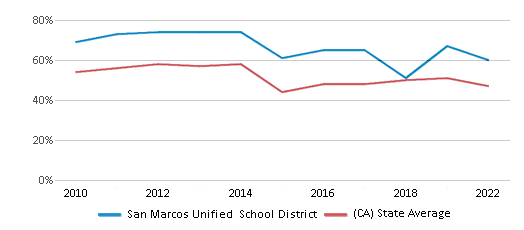
Science Test Scores (% Proficient)
39%
29%
Graduation Rate
95%
87%
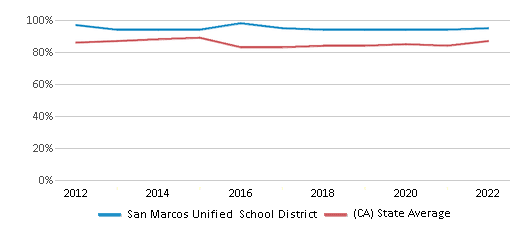
Students by Ethnicity:
Diversity Score
0.65
0.63
# American Indian Students
25 Students
10,468 Students
% American Indian Students
n/a
1%
# Asian Students
1,563 Students
244,247 Students
% Asian Students
8%
11%
# Hispanic Students
8,937 Students
1,190,384 Students
% Hispanic Students
46%
56%
# Black Students
200 Students
110,575 Students
% Black Students
1%
5%
# White Students
7,084 Students
458,887 Students
% White Students
37%
22%
# Hawaiian Students
53 Students
9,060 Students
% Hawaiian Students
n/a
n/a
# Two or more races Students
1,487 Students
108,483 Students
% of Two or more races Students
8%
5%
Students by Grade:
# Students in PK Grade:
-
18
# Students in K Grade:
1,699
25,126
# Students in 1st Grade:
1,345
19,346
# Students in 2nd Grade:
1,320
19,826
# Students in 3rd Grade:
1,368
19,554
# Students in 4th Grade:
1,390
19,798
# Students in 5th Grade:
1,454
20,237
# Students in 6th Grade:
1,422
29,089
# Students in 7th Grade:
1,545
39,371
# Students in 8th Grade:
1,468
41,955
# Students in 9th Grade:
1,433
466,491
# Students in 10th Grade:
1,571
476,582
# Students in 11th Grade:
1,603
469,509
# Students in 12th Grade:
1,737
492,623
# Ungraded Students:
-
-
District Revenue and Spending
The revenue/student of $18,236 in this school district is less than the state median of $19,974. The school district revenue/student has stayed relatively flat over four school years.
The school district's spending/student of $14,948 is less than the state median of $18,396. The school district spending/student has stayed relatively flat over four school years.
Total Revenue
$353 MM
$116,387 MM
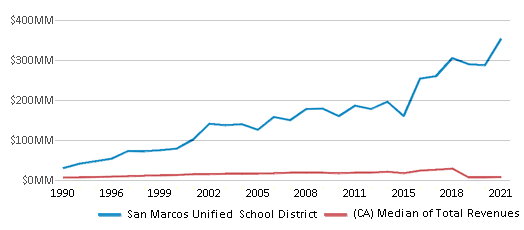
Spending
$289 MM
$107,188 MM
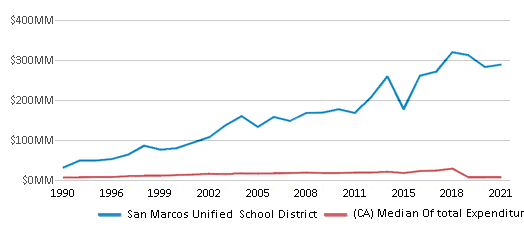
Revenue / Student
$18,236
$19,974
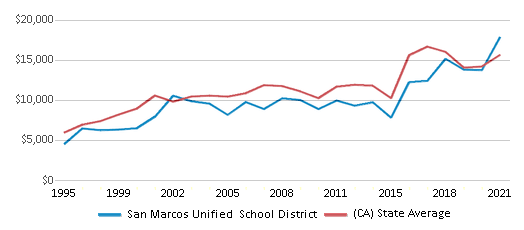
Spending / Student
$14,948
$18,396
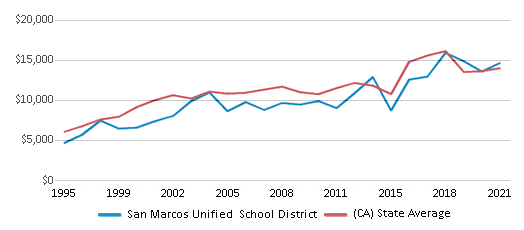
Best San Marcos Unified School District Public High Schools (2025)
School
(Math and Reading Proficiency)
(Math and Reading Proficiency)
Location
Grades
Students
Rank: #11.
Foothills High School
Alternative School
(Math: 35-39% | Reading: 60-64%)
Rank:
Rank:
8/
Top 30%10
158 Cassou Rd.
San Marcos, CA 92069
(760) 290-2544
San Marcos, CA 92069
(760) 290-2544
Grades: 9-12
| 110 students
Rank: #22.
San Marcos High School
(Math: 33% | Reading: 59%)
Rank:
Rank:
7/
Top 50%10
1615 San Marcos Blvd.
San Marcos, CA 92078
(760) 290-2200
San Marcos, CA 92078
(760) 290-2200
Grades: 9-12
| 3,201 students
Rank: #33.
Mission Hills High School
(Math: 29% | Reading: 65%)
Rank:
Rank:
7/
Top 50%10
1 Mission Hills Ct.
San Marcos, CA 92069
(760) 290-2700
San Marcos, CA 92069
(760) 290-2700
Grades: 9-12
| 2,834 students
Rank: #44.
Twin Oaks High School
Alternative School
(Math: ≤10% | Reading: 10-14%)
Rank:
Rank:
1/
Bottom 50%10
158 Cassou Rd.
San Marcos, CA 92069
(760) 290-2555
San Marcos, CA 92069
(760) 290-2555
Grades: 9-12
| 213 students
Recent Articles

What Is A Charter School?
Explore the world of charter schools in this comprehensive guide. Learn about their history, how they operate, and the pros and cons of this educational innovation. Discover key facts about charter schools, including admission policies, demographics, and funding, as well as what to look for when considering a charter school for your child.

10 Reasons Why High School Sports Benefit Students
Discover the 10 compelling reasons why high school sports are beneficial for students. This comprehensive article explores how athletics enhance academic performance, foster personal growth, and develop crucial life skills. From improved fitness and time management to leadership development and community representation, learn why participating in high school sports can be a game-changer for students' overall success and well-being.

February 05, 2025
Understanding the U.S. Department of Education: Structure, Impact, and EvolutionWe explore how the Department of Education shapes American education, from its cabinet-level leadership to its impact on millions of students, written for general audiences seeking clarity on this vital institution.





